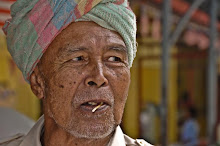Renyok Intake Road, Jeli 20th October 2010
Even with their loud, hoarse, gruff ‘chachachacha’, you’ll have to carefully search the location in order to locate them. Their habit of sitting motionless and leaf-green color of their plumage make them difficult to spot. From my observation, their behavior and colorations actually helped them in catching their prey.
See how well this female RB Bee-eater ( more red, less purple on crown) blends with the green background.

From a distance, bees and other insects are lured by the bright red, pinkish purple color of the head, which resemble a pretty flower full of nectar. As the bees get within range, all she has to do is just grab them or sometimes make a short dash to catch the prey – pretty clever trick!
A female RB Bee-eater swirling her head while trying to catch some insect from her perch.

Returning to her perch after a short dash to grab her prey.

The female RB Bee-eater above was shot in Kg. Lawar 4 days earlier. This male RB Bee-Eater (all pinkish-purple crown) was shot near Renyok Intake on the 20th Oct. 2010. I noticed that he was not hunting hence the preference for a more open area.

Even in open area, I think bees and other insects will still be attracted by the color….


They attract not only bees and insects, but photographers too !

























































.jpg)




